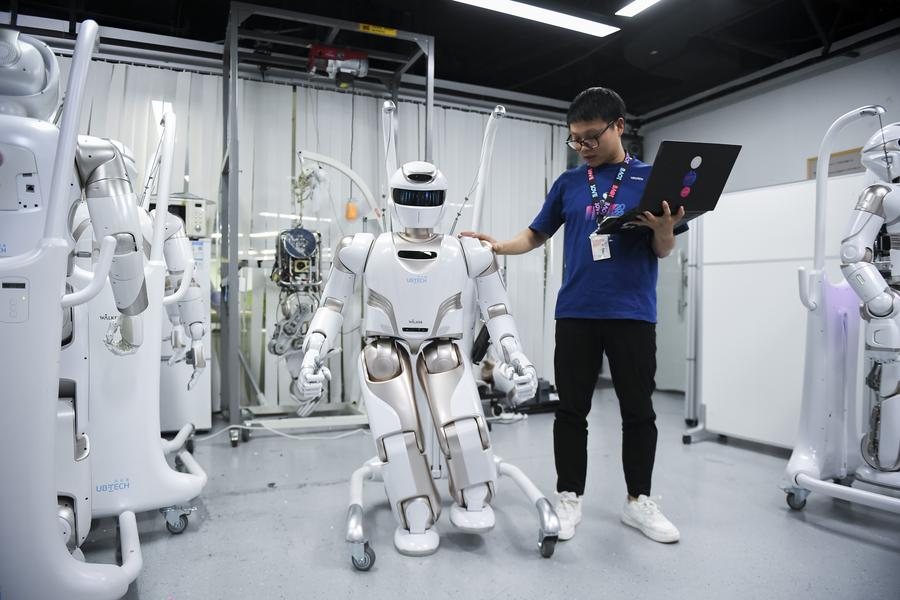


A staff member conducts tests on a Walker X humanoid robot at a sci-tech company in Shenzhen, south China's Guangdong Province, June 26, 2024. (Xinhua/Mao Siqian)
BEIJING, Dec. 29 (Xinhua) -- The explosive growth of humanoid robots represents a standout transformation in China's tech innovation landscape for 2024.
As robust capital inflow fuels the emerging sector, the human-shaped machines are being fine-tuned for superior agility, and their versatile applications are becoming increasingly evident across a range of scenarios.
"Humanoid robots have now reached the educational level of a high school junior or senior, and are expected to sit the college entrance exam as early as next year, which means their deployment in more scenarios," said Hu Debo, CEO of Shanghai-based Kepler Robot.
NEW CAPABILITY
In March, Hangzhou's Unitree Robotics released a remarkable video featuring their 50-kg Unitree H1 humanoid robot executing a standing backflip, a first for full-scale electric-driven humanoids.
Two months later, a robot developed by Beijing-based RobotEra ascended the Great Wall, showcasing its stability and strength in different types of terrain. The Beijing-based startup's new STAR1 model also completed a long-distance run in China's Gobi desert in October, reaching speeds of six meters per second.
Engine AI from Shenzhen unveiled the robot with the most human-like gait, with the promotional video going viral immediately.
The evolution of these robots has captured people's attention on social media platforms and also secured substantial venture capital to fuel their growth.
From January to October 2024, there were at least 69 global humanoid robot financing events, amounting to over 11 billion yuan (1.51 billion U.S. dollars), with 56 of these occurring in China, totaling more than 5 billion yuan, as per partial data from GGII, a Shenzhen-based consultancy for emerging industries.
The market size of humanoid robots in China in 2024 is approximately 2.76 billion yuan, according to a blue paper published recently.
AI-DRIVEN
Now, the artificial intelligence (AI) has served as the "engine" driving this progress.
"The deep integration of humanoid robots with AI constitutes a significant trend in the robotics industry this year," said Yang Fengyu, founder and CEO of UniX AI, a robotics technology company based in Shanghai.
"In the past, robots lacked autonomous motion control capabilities and could only perform single tasks in a fixed environment, struggling to adapt when the environment changed," Xiong Youjun, general manager of Beijing Humanoid Robot Innovation Center, told Xinhua.
The advancement of AI's large-scale models not only makes robots more intelligent, but also significantly lowers their production costs.
China boasts a comprehensive supply chain and manufacturing infrastructure, enjoys good policy support and vast market potential, and has an ample reserve of technical talent, said Xiong.
APPLICATIONS
This month, a Chinese tech firm declared the start of large-scale production for general-purpose robots. AgiBot, a startup established in February 2023, has already produced nearly 1,000 units of these humanoid robots.
Automotive production lines are among the fastest deployment scenarios for humanoid robots. UBTECH Robotics, a leading robotics firm based in Shenzhen, has integrated their products into the training programs of automotive manufacturers like BYD, NIO and Geely.
Xpeng, another new-energy vehicle manufacturer, has ventured into robotics directly, with its self-developed robots now being trained in factory settings.
The development of humanoid robots for caregiving services in households has begun to take shape, although their implementation is slower than in industrial settings.
In September, Tencent's Robotics X Lab revealed "The Five," a hybrid home-help robot featuring four-wheels, tactile skin and hands. Laboratory test footage demonstrates that the residential robot is capable of walking, carrying objects, and assisting seated elderly individuals in standing up at an elderly care home in Shenzhen.
"The Five" is still at the prototype stage and needs additional technological refinements before it can be effectively deployed in nursing homes, according to Robotics X.
The Chinese humanoid robot market, which is on the verge of a boom, still faces several challenges. The rapid growth is hindered by "dependence on overseas high-end chips and proprietary algorithms, along with a shortfall in domestic computational resources," said Xiong. ■
点击右上角![]() 微信好友
微信好友
 朋友圈
朋友圈

请使用浏览器分享功能进行分享
